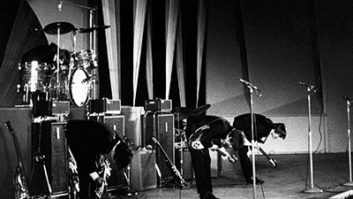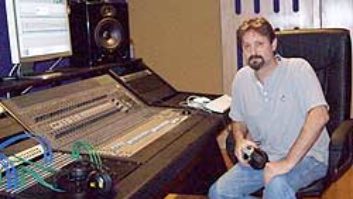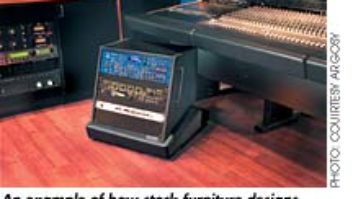REDWAY, CA—Robert Seifert Gage’s life has been a long, strange trip. Since escaping the rat race of freelance engineering in Los Angeles in the eighties and early nineties, Gage has been enjoying family life and the forests of Humboldt County for the past 20 years, most recently recording in his Audio Evidence Mobile truck.
Gage worked at some of the great L.A. studios in the eighties—Crystal, Paramount, Encore, A&M, Aire L.A., Shangri La—while building a client list that included Porno for Pyros, Skinny Puppy, Eels, Mike Watt, Chuckii Booker and numerous others, many of those records made working alongside mentor Eric “ET” Thorngren. “But I’d start a job, then I’d be out of work; I was always looking for another job. I wanted to be in a place where people remembered me, and I could have a good relationship with everybody in the community, help people, learn new skills, learn how to work on homes, live on the land. That’s why I left L.A.,” says Gage.
A kids album project for Bob Marley’s mother in 1991 had brought Gage into contact with the Music for Little People label. In 1994, the label invited him to Humboldt County. “I recorded all the heavyweights in the movement to save the redwoods for the first five years of being here. And the neighborhood had tons of musicians; it blew me away. I ended up meeting all these guys that were farmers and teachers and building houses. But they also were music lovers and played together in lots of bands.”
It was a big change after L.A.’s SSL and Neve studios, he says. “I came here with nothing—no audio gear—and moved into a house studio that had Mackies and ADATs, and made 25 of my favorite-sounding kids records.”
Gage subsequently adopted PreSonus Studio One DAW software. “They had just come out with it. I downloaded the demo and within an hour was remixing a Peter Gabriel song. I was hanging out in the woods with my wife and the dog, we had just had a kid—it was a beautiful moment. I had so much fun that I got in touch with Rick Naqvi [VP of sales] at PreSonus. He loved my credits.”
Endorsement deal in hand, Gage has been adding PreSonus gear to his system and those of his friends ever since. “A main piece of my studio is a 32-channel PreSonus Firestudio Lightpipe. I was looking for the easiest, cheapest way to use my analog gear. I also have the Universal Audio 4-710D. That’s my final input back into the computer—that thing changed my life.”
Gage had also decided to become an archivist. “I was documenting my friend, months before he passed. I thought that would be a cool thing to do for the hospice here, document these people’s lives.”
Around the same time, he signed on as front-of-house engineer at the Mateel Community Center, which has hosted an eclectic list of artists from Merle Haggard to the Wu Tang Clan. The venue boasts two analog Gamble EX56 desks, serial numbers 1 and 13, sourced by Gage. He archives shows to a Mackie HDR24 or a Zoom H5. “I’ve been trying to find a way to get the Mateel to put them on a web site or in a vault,” he says. Gage was initially looking for an ambulance for his mobile archiving studio when his brother, a fireman, called with news that the county was selling its evidence van, a 1989 Chevy P30 step van. “He invested, my mom invested; it was so cheap, and had only 1,965 miles on it,” he says.
The van, dubbed Audio Evidence Mobile, now includes acoustic treatment and a custom desk built recently by a friend, musician and woodworker Chris Manspeaker. ��I sent a photo to Danny McKinney of Requisite Audio and said, what do I need in this van? He said, you need a rear wall diffusor-absorber, first and foremost. I shot my ‘room’—I have a spectrum analyzer—and notated what frequencies were dipping or stepping out. Chris did the math and made me a perfectly symmetrically balanced back wall from recycled wood,” Gage reports.
For a project by Angels Cut, now signed to Universal, Gage parked at the band’s house in nearby Benbow, CA. “They would rehearse Tuesday and Wednesday, and Thursday we would record. Then I would do overdubs with the singer and guitar player. They’d go to work and I’d just edit in their driveway. I’m in that box and eight hours just go by.”
He prefers recording bands live. “I needed to deck out my van so that I could do at least 16 channels of killer inputs. We can fix anything later, but we need to get that energy.”
His equipment list is lengthy, including pieces from Allen & Heath, Audio Upgrades, Dangerous Music, DIYRE, Focusrite, Trident/MTA and Requisite Audio, among many others. The mic locker features Blue, Gauge, Sennheiser, Shure, Studio Projects and Telefunken models.
He needed to buy more gear for the Angels Cut record. “We were recording and the singer, Stephanie Johnson, couldn’t hear herself. I stopped recording and said, we’ll be back in a few days. I now have a Hear Technologies Mix Back system.”
Gage is obviously enjoying the van’s benefits: “I think I’ve got a unique thing going on. It’s serving me and my passion.”
PreSonus
presonus.com







